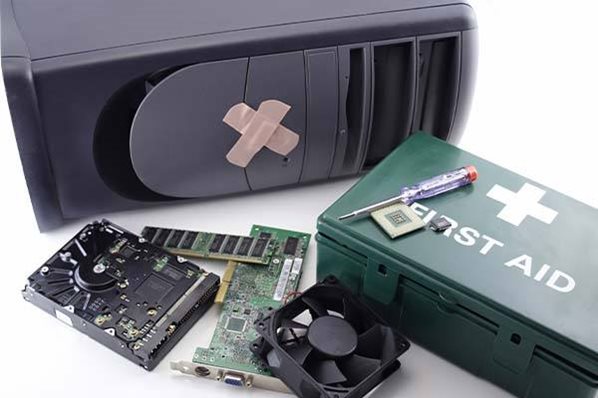Think for a moment about the first car that you owned. It most likely wasn’t brand new (mine certainly wasn’t, that’s for sure). When an older vehicle is taken to a mechanic to be repaired, sometimes the new parts placed in the car are not compatible with the older components. In turn, this causes more issues. Then, of course, more repairs are needed for the vehicle to be operational (and so on, and so on). So, what does this have to do with break/fix IT or managed IT? Well, put on your seat belt because we’re about to tell you.
The Break/Fix IT Model
The car situation is very similar to the break/fit IT industry. For example, suppose your company continues to call a break/fix IT guy to come in and repair a particular computer which (unbeknownst to your company) has a failing hard drive. One day that old computer with the bad hard drive stops working, and all the money paid to fix the issues along the way is wasted because your company still has to buy a new hard drive and have it installed. Not to mention, all the files on that hard drive are now entirely lost (if they were not backed up by your break/fix IT guy). This also doesn’t account for the 1-2 hours your employees spent trying to fix the problem first. Unfortunately, this is a very typical experience that businesses have with the break/fix IT model.

The Managed IT Model
With the rapid changes occurring in the IT industry every day (or some may argue every hour) new business models are emerging and continually improving. One of those is the managed IT services model. With the onset of the cloud, this model of managing IT has exploded and is improving productivity for many businesses. It is even positively impacting revenue for some companies. In the managed IT services model, your business partners with an IT firm that takes on managing all your IT-related needs. For example, with our managed IT service, we put all of an organization's IT assets in a controlled environment that continuously monitors all IT assets and user activities. This environment is highly secure and provides backups of all workstations and servers. The managed IT model is very much the opposite of the above break/fix scenario.

Break/Fix Drawbacks vs. Managed IT Benefits
There are several significant drawbacks to the break/fix IT model. One of those drawbacks is that the response time of the typical break/fit IT guy is much slower than a managed IT service. This is because you usually have a single IT person (assigned to your account) and they provide all the break/fix IT services to your business. They are responsible for traveling to your office and fixing your issues as you create support tickets with their company. Many times, these visits can be delayed due to other clients in the queue, or if your organization has problems across multiple locations, it can be challenging for them to solve all the issues (all at once) with only one set of hands.
With the managed IT model, your IT assets are placed in an environment that continuously monitors them. This means that the IT team you have in place will know when there are potential issues and they can fix them before problems arise for your employees. The managed IT monitoring feature keeps your employees productive and focused on their jobs, rather than waiting for someone else to come in and fix the printer or internet connection.
Working with an IT company that applies a break/fix model for IT is also incredibly costly. According to Continum.net, 44% of businesses lose an average of $10k+ for every hour of employee downtime. And that stat is just from a loss of productivity. Remember, the cost to repair a device multiple times without fixing the root issue is not included here. Also not included are the hours spent by your employees trying to fix the problem before they even call the IT guy. Continum.net also reports that 140,00 hard drives crash in the United States every week! This, and other recurring IT problems, are issues that should be monitored and fixed proactively (not after they break).

At this point you may be thinking: How can a system that continuously monitors everything be less costly than just fixing broken IT stuff as it happens? Great question! There is usually a one-time onboarding fee to get your company set up in the monitored IT environment. Then you have a recurring service fee each month to keep those assets managed and make sure all your backups are in place and running smoothly.
With managed IT, there is also a cost per IT ticket. Let’s face it, technology is not fail-proof. Users make mistakes and sometimes need help getting things done with technology. Ticket cost is added to your monthly fee. However, since your company stays under constant IT monitoring, ticket costs may go down. Your systems will usually need a decent bit of TLC to get them running smoothly at first, but after that, you will notice that issues rarely come up unless they are related to user-error, internal security breaches, or advancements in technology.
The Full Picture
Keeping your employees doing their jobs saves you money! The managed IT services model does just that! As Forbes reports, companies typically see four key benefits with managed it services: improved operational performance, reduced operational risk, cost avoidance and accelerated innovation. So which model do you choose? Should you go with the old break/fix sticky band-aid solution or the new and improved managed IT service model?
You must make this decision based on business goals. If you do not mind the interruptions of daily IT problems and the cost of downtime or data loss, then break/fix IT is the right choice for your business. On the other hand, if your company needs to stay productive and focused, then managed IT is your best bet.
Remember, there is always some cost involved when making the right choice, and with any necessary business purchase, the cost should be weighed according to the overall value it brings to your company. If you have questions about managed IT, or you’re ready to get started with our services, contact us today.